Tragedy at Tempe
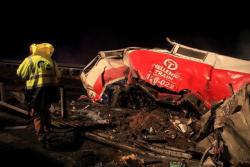 At 11:20pm on Tuesday 28th February 2023, two trains collided that were on the same track in the Vale of Tempe, near Larissa. One was an InterCity Express carrying over 350 people from Athens to Thessaloniki, which collided head-on with a goods train travelling in the opposite direction to Larissa. Many of the passengers on the Express train were young students returning north from celebrating the long weekend of Carnival and Clean Monday. The death toll from the tragic accident at Tempe has so far reached 57, with all those originally reported missing having been included in the list of the dead. The rescue, search and extrication operation in the area was in progress throughout the night, and expected to continue for the next couple of days as heavy lifting equipment is expected to arrive soon.
At 11:20pm on Tuesday 28th February 2023, two trains collided that were on the same track in the Vale of Tempe, near Larissa. One was an InterCity Express carrying over 350 people from Athens to Thessaloniki, which collided head-on with a goods train travelling in the opposite direction to Larissa. Many of the passengers on the Express train were young students returning north from celebrating the long weekend of Carnival and Clean Monday. The death toll from the tragic accident at Tempe has so far reached 57, with all those originally reported missing having been included in the list of the dead. The rescue, search and extrication operation in the area was in progress throughout the night, and expected to continue for the next couple of days as heavy lifting equipment is expected to arrive soon.
The first four carriages of the Athens InterCity Express train were derailed, with the first two carriages engulfed in fire which made rescueing passengers extremely difficult. Rescue services were at the scene in about half an hour, with some passengers being able to assist others to escape by breaking windows before they arrived. Sadly, most of the passenges in the first two carriages were not as fortunate, as the ensuing fire made it impossible for them to escape, or to get to them in time. The collision of the two trains is already the country's deadliest ever, with more than 48 people taken to various local hospitals, with six in intensive care.
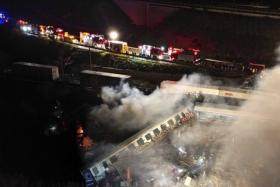
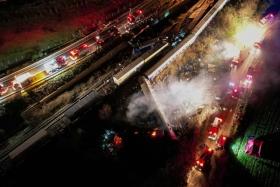
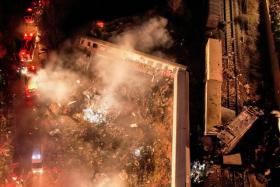
On impact, the front carriages exploded into flames, sending hugh sheets of steel and smoke into the air. Survivors later spoke of being ejected from carriage windows, other described how they had to struggle through plumes of acrid smoke to escape after the train buckled. One survivor said, "a lot of passengers didn't understand what exactly had happened because they were asleep. I was sleeping too and the sudden breaking shook me awake. When we realised what had happened, we tried to get out of the wagons, and when we managed that, we saw the chaos". From early on, the spotlight fell not only on the arrested station master, blamed for the 'human error' that caused the collision, bit also on the dire state of the whole Hellenic National Railway system.
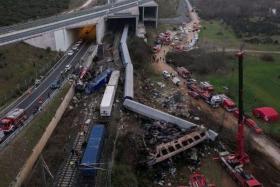
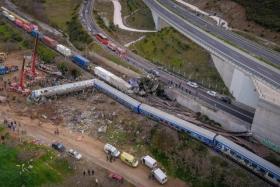
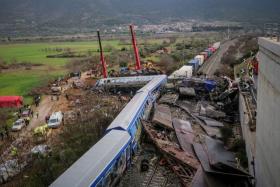
Annoncing his resignation after visiting the crash site, the Greek transport minister, Kostas Karamanlis, said the rail network was so flawed it did "not befit the 21st century". Stepping down was not only "a mark of respect towards the memory of the people who died so unfairly" but an assumption of responsibility "for the Greek state's and Greek political system's mistakes over the course of history". The Greek prime minister, Kyriakos Mitsotakis, who also arrived at Tempe, called a three-day period of official mouring, ordering flags to fly at half mast. Meanwhile, the tragic death toll from the fatal train collision accident at Tempe continued to rise.

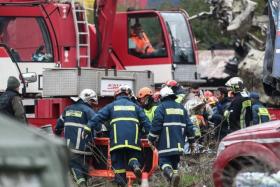
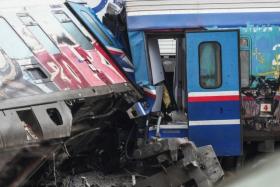
A 48-hour national railway workers strike is to begin at 06:00am on Thursday 2nd March in protest of the conditions railworkers are expected to work in, hitting national rail services and the Athens subway. Many in Greece see the crash as an accident waiting to happen, and the rail union blamed successive governments 'disrespect' towards the Greek railways for leading to this tragic result. Rail workers unions are now planning to extend the national railway strike from Saturday 4th through to Sunday 12th March 2023.
Critics blame a lack of public investment during the deep financial crisis that spanned most of the previous decade and brought Greece to the brink of bankruptcy. It was during this crisis, in 2017, that Greek operator TrainOSE, then heavily losing money, was privatised and bought by Italy's Ferrovie dello Stato Italiane Group, operating as Hellenic Train, who have been operating the Greek rail network since then. Greece has a limited rail network that doesn't reach much of the country. Despite years of modernisation projects, much of the key rail control is still manually operated, as is the entire network where the Tempe head-on collision occured.
The president of the train drivers' association revealed that the electronic systems that warn drivers of danger ahead have not been working for years. "Nothing works, everything is done manually. We are in 'manual mode' throughout the Athens-Thessaloniki railway network. Neither the indicators, the traffic-light signals or the electronic traffic control is working". Officials launched a judicial inquiry to determine how two trains travelled in opposite directions, on the same track, for more than ten minutes without anyone raising the alarm. If a modern safety system had been in place as planned years ago, it would have been all but impossible for a freight train to end up on the same track as a crowded passenger train. Warnings would have sounded and automatic brakes would have kicked in on both the trains, avoiding the horrific tragedy of death, injury and destruction at Tempe.
Health minister Thanos Plevris noted that all the work to record the passengers killed or injured in the crash was done by EKAV ambulance rescue crews, with no help from the Hellenic Train company. There was no one from the company in the hospitals to help us. Hellenic Train is often in the news for delays, poor services or even accidents that were avoided at the very last moment.


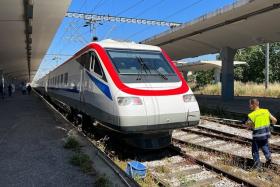
'Greece has the worst railway system in Europe' . . . despite getting €700 million in modernisation money from the EU since 2014. Under various national governments, the country's 2,552 kms (1,585 miles) of rail network has been constantly plagued by mismanagement, poor maintenance and outdated equipment for many decades, not just the years during the financial crisis. Anyone who has been on a train in Italy, France, Germany, Scandinavia or other European countries will tell you there is simply no comparison. Greek trains can only be compared to those presently in service in Egypt, Turkey or Bulgaria, and are perhaps slightly superior to those found in India or Bangladesh. In Greece, train travel has never been the primary form of land transport. The result has been an antiquated network of railways and trains, despite the occasional patchy attempt to modernise the rail system.
The station master in Larissa has admitted responsibility for the accident and is expected in court on Sunday 5th March, charged with negligent homicide. The 59-year old man is devastated, but his lawyer said 'there has been convergent negligence by many other factors'. The Larissa station master had been appointed to the post by OSE just 35 days earlier, after five months of training.
UPDATE: Station master Vasilis Samaras, has been prosecuted and jailed, pending trial, following a 7-hour hearing in Larissa. He was charged with multiple counts of negligent homicide and bodily harm, endangering transport safety and obstructing the route. The hearing heard that Samaras was the only station master on duty that night, when there should have been three station masters present when the delayed InterCity-62 passenger train departed from Larissa. When Samaras turned up to start his night-shift at 10:00pm, the other two station masters left, leaving him responsible for controlling the whole railway system of central Greece. These two station masters and their railway inspector, Dimitris Nikolaou, 63, were also later charged on Thursday with the same charges as Samaras, although the two station masters were later released on bail.
Greek PM apologised on social media at the weekend for government failings, past and present, as the first on the funerals of passengers were being carried out. Numerous demonstrations were held in major cities across the nation following the rail disaster, with a 24-hour National Strike called for Wednesday 8th March across the whole country regarding safety on public transport. The centre of Athens became inaccessible due to the rallies taking place, with demonstrations also taking place in Thessaloniki, Patras, Heraklion, Larissa and Ioannina. Strikers demanding that there be no cover-up for those responsible for the tragedy at Tempe. There were further protest demonstrations in major cities the following weekend, with a further 24-hour national strike planned for Thursday 16th March 2023.
Recovery crews slowly cleared the last sections of the damaged Athens-Thessaloniki IC-62 carriages from the crash site following the end of the recovery search period for bodies of passengers. The only survivor of the first train carriage is still in intensive care. The 20-year old male student remains in the ICU in a critical condition and fighting to stay alive, undergoing two head surgeries.
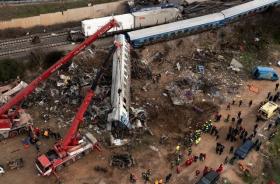

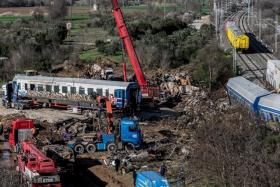

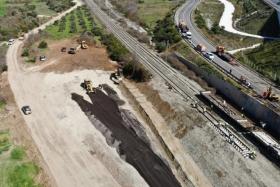
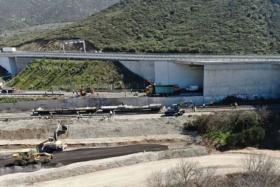
The Greek Minister of Transport announced on Tuesday 14th March that the country's railways will gradually return to normal service from 22nd March 2023, three weeks after the deadly head-on Tempe rail disaster. All passenger and freight rail services throughout Greece have been suspended since the tragic train crash. The railway network restart will unfold in five phases, beginning with the suburban railroad lines between Piraeus, Athens and the International Airport, in addition to the freight train service between Athens and Thessaloniki. It is planned that a limited InterCity passenger service between Athens and Thessaloniki will resume from Monday 2nd April 2023. The minister concluded, "as it is important and necessary to regain public confidence as we move ahead to a substantial railway upgrade, which has unfortunately been lagging for decades".
A small chapel has been built at the crash site and a memorial service was held for the victims of the rail disaster on Palm Sunday, 9th April, 40 days after the tragic accident. Many tearful relatives of the victims left lit candles, flowers and notes on the trackside.